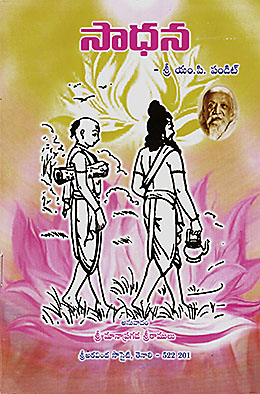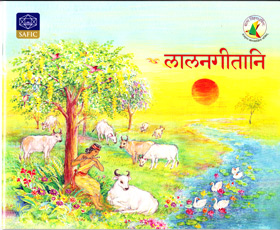

|
The Mother called Savitri “the supreme revelation of Sri Aurobindo’s vision” and stressed the importance of reading it every day because each time one reads it, new experiences are revealed, a new understanding emerges. Sri Aurobindo’s epic poem features in four of the five English publications introduced in this issue. Meditations on Savitri—Vol. IV with 100 paintings by Huta covers Book Eight to Book Twelve. The Mother and Huta meditated together on lines chosen from Savitri, and the Mother described her vision evoked by those lines to Huta, with the help of a few pencil strokes. Huta then completed the work in her studio as an oil painting. This is the final volume of the paintings. Volume V will collect the Mother’s sketches that formed the basis for Huta’s paintings.
Many scholars, devotees and Savitri-lovers have written summaries, introductions, and explanations of Sri Aurobindo’s poem. Dr Judith Tyberg (Jyotipriya), in her own summary of Savitri, wrote that “its spiritual conception is so all-embracing, so integral that it gives birth to a power which transforms life on earth to a life of divine activity rather than leading to an escape from life. The epic is a mantric expression of this great Seer-sage’s inner findings and conquests, leading to his vision of an age of truth-consciousness and immortality.” The next three books are all aimed at helping the reader reach a better understanding of Savitri. They each take a different approach, allowing for individual capacities to absorb the broad themes of the poem. Invitation to Sri Aurobindo’s Savitri by M. V. Nadkarni is based on a series of thirty-one talks he gave to introduce the poem to readers. The author was a noted speaker on Savitri, and this series covers the entire epic as well as chapters on how to read Savitri and comparisons with the original legend. There is also a glossary of Sanskrit terms used in the poem and references for the many quotations from Savitri and from other texts by Sri Aurobindo cited by the author. Shraddhavan has brought out a very brief, concise handbook on Savitri by compiling one-page summaries of each canto from the works of M. P. Pandit and from the work of members of the Gruppo Germoglio of Modena, Italy. An Introduction to Sri Aurobindo's Epic Savitri acts as a guide to understanding how the poem progresses so that the reader may more closely follow the text and appreciate the images, symbols, and poetry. It also provides an introductory reading list of reference works and studies by various authors. Yet another approach is featured in A Focused Journey through Sri Aurobindo's Savitri.The book is a collection of extensive excerpts drawn from Savitri that cover all the cantos of the poem, with subtitles by the compiler that attempt to highlight the central message and theme of the passage. The final English book introduced below is a pictorial journey—Auroville 1968–2018: Glimpses into 50 Years of Photographic Archives. It captures the people and places of Auroville, and gives a vivid sense of Auroville life in such fields as education, the creative arts, scientific research and experimentation in sustainable energy, soil and water conservation, and architecture. Highlighted are the inauguration ceremony in 1968, the construction of the Matrimandir, and Auroville’s golden jubilee celebration held on 28 February 2018.
| |||||||||||||||||||||||||||||||||||||||||||||||||||||||||||||||||||||||||||||||||
| |||||||||||||||||||||||||||||||||||||||||||||||||||||||||||||||||||||||||||||||||
ENGLISH | |
 | Meditations on Savitri — IV
Book Eight – Book Twelve — Paintings by Huta under the Mother's guidance ISBN: 978-81-87372-40-0 Publisher: The Havyavahana Trust, Pondicherry Binding: Hard Cover Pages: 225 Price: Rs 1250 |
This is the fourth volume in a series that presents all of the 472 paintings on Savitri made by Huta under the Mother's guidance. From 1961 to 1966 the Mother and Huta meditated together on lines chosen from Sri Aurobindo's Savitri, and when an image appeared to the Mother she described it to Huta with the help of a few strokes. Huta then completed the work in her studio as an oil painting. The Mother named the series of paintings Meditations on Savitri. This volume of 100 paintings accompanied by the corresponding lines from Savitri covers "The Book of Death" (7 paintings), "The Book of Eternal Night" (22 paintings), "The Book of the Double Twilight" (24 paintings), "The Book of Everlasting Day" (34 paintings), and "Epilogue: The Return to Earth" (13 paintings). | |
 | Invitation to Sri Aurobindo's Savitri
Based on a series of talks in Pondicherry — M. V. Nadkarni ISBN: 978-81-7060-400-6 Publisher: AuroPublications, Sri Aurobindo Society, Pondicherry Binding: Soft Cover Pages: 426 Price: Rs 450 |
The first chapter of this book, which is based on the author’s series of thirty-one talks introducing the poem, lays down a few key principles in his approach to the subject. First, that in writing Savitri, Sri Aurobindo was leaving for posterity a verbal embodiment of his own consciousness. Then, through the poetry he was flooding the earth atmosphere with the vibrations of hope and love in an age already wallowing in nihilism, building a bridge between this world of human limitations and the future world that he was opening up. And that is why the writing of Savitri is a very significant event in human history. The transcribed talks cover the entire epic as well as chapters on how to read Savitri and comparisons with the original legend. The book concludes with a glossary of Sanskrit terms used in the poem and references for the many quotations from Savitri and from other texts by Sri Aurobindo cited by the author. | |
 | An Introduction to Sri Aurobindo's Epic Savitri — A Legend and a Symbol
— Compiled by Shraddhavan ISBN: 978-93-82474-28-9 Publisher: Savitri Bhavan, Auroville Binding: Soft Cover Pages: 67 Price: Rs 125 |
Beginning with Sri Aurobindo’s own Author’s Note on Savitri, some statements of the Mother on Savitri, and a note on how the poem developed over the years from 1916 to 1950, this concise handbook then very briefly summarises each canto of the entire epic. Compiled by Shraddhavan of Savitri Bhavan, the summaries are based on work by M.P. Pandit and members of the Gruppo Germoglio of Modena, Italy. The book concludes with an introductory reading list of reference works and studies by various authors. | |
 | A Focused Journey Through Sri Aurobindo's Savitri
(Selections from Savitri) — Edited by Chandra Prakash Khetan ISBN: 978-81-86510-29-2 Publisher: Sri Aurobindo Divine Life Trust, Jhunjhunu Binding: Hard Cover Pages: 454 Price: Rs 600 |
A collection of extensive selections from Savitri covering all the cantos of the poem, this book attempts to guide the reader by providing titles to the selections that highlight the central message and theme and throw some light on the content of the passage itself. It also includes chapters on what Sri Aurobindo and the Mother said about Savitri, the story of Savitri from the Mahabharata, and a look at the original legend vis-à-vis Sri Aurobindo’s treatment that gave us Savitri: a Legend and a Symbol. | |
 | Auroville 1968–2018: Glimpses into 50 Years of Photographic Archives
— Sri Aurobindo International Institute of Educational Research (SAIIER) ISBN: 978-93-82474-23-4 Publisher: Sri Aurobindo International Institute of Educational Research, Auroville Binding: Hard Cover Pages: 447 Price: Rs 5300 |
Celebrating fifty years through photographs, this book is a dynamic visual narrative of Auroville’s development. Although the photographs, both familiar and fresh, do not follow a strict chronological order, there are recurrent themes that provide a historical perspective. It begins with the local inhabitants of the land on which Auroville is built, followed by photos of the inauguration ceremony in 1968 and the first settlers to arrive on the dusty plains, some very dramatic photos of the Matrimandir construction, and ends with the golden jubilee celebration on 28 February 2018. Interspersed are photographs of several people who played a role in supporting the growth of Auroville, a photomontage of Auroville’s children, studying, playing, and growing up before our eyes, and views of Auroville life through the creative arts, sport, experimental architecture, alternative energy, village development, quiet moments of contemplation in the beauty of the growing surroundings, and informal portraits of its residents. | |
FRENCH | |
 | Journal du Yoga: Livre III
1915 - Fin 1919 — Sri Aurobindo ISBN: 978-81-902032-6-5 Publisher: Aurobhasha, Auroville Binding: Soft Cover Pages: 522 Price: Rs 2250 |
 | Journal du Yoga: Livre IV
1920 - 1927 — Sri Aurobindo ISBN: 978-81-902032-8-9 Publisher: Aurobhasha, Auroville Binding: Soft Cover Pages: 345 Price: Rs 1560 |
Les livres 3 et 4 du Journal du Yoga couvrent la période du 1er janvier 1915 au 31 décembre 1927. Le Journal du Yoga est l’« Agenda » de Sri Aurobindo. Chaque jour Sri Aurobindo note l’évolution de sa sâdhanâ [discipline spirituelle], selon le « programme » qu’il reçoit intérieurement quelque temps après son arrivée à Pondichéry en 1910. Ainsi est tracé jour après jour, dans tous ses détails, le parcours d’un yoga « incalculable, soumis à nulle règle, modèle, dogme ou shastra. » Ce développement yoguique culmine en décembre 1926 avec la réalisation des « Sept Soleils du Supramental », la découverte du « huitième Soleil de Vérité caché au sein de la Terre », puis du « Supramental suprême » en 1926-27 | |
ITALIAN | |
 | Lo Scopo della Vita
— Sri Aurobindo e Mère ISBN: 978-93-5210-202-0 Publisher: Domani, Pondicherry Binding: Soft Cover Pages: 43 Price: Rs 130 |
Ha detto la Madre: | |
HINDI | |
 | Shrimadbhagavad Gita (Bhag 2)
Mool tatha anuvad sahit — Compilation from the Works of Sri Aurobindo with commentary ISBN: 978-81-86510-31-5 Publisher: Sri Aurobindo Divine Life Trust, Jhunjhunu Binding: Soft Cover Pages: 558 Price: Rs 450 |
This book, based on a series of study classes conducted at the Sri Aurobindo Divine Life Education Centre, includes a detailed commentary on a Hindi translation of the eighth to eighteenth chapters of The Bhagavad Gita: With Text, Translation and Commentary in the Words of Sri Aurobindo, presenting each verse of the Gita's original Sanskrit text along with its translation based on Sri Aurobindo's Essays on the Gita. The slokas are followed by notes compiled from the works of Sri Aurobindo and the Mother. | |
BENGALI | |
 | Arther Mulya
— Sri Aurobindo O Srima Publisher: Sri Aurobindo Society, Kolkata Binding: Soft Cover Pages: 40 Price: Rs 40 |
| |
GUJARATI | |
 | Sri Matajinu Param Sannidhya
— Shobha Mitra Publisher: Sri Arvind Yog Sadhana Kendra, Navsari Binding: Soft Cover Pages: 224 Price: Rs 150 |
Gujarati translation of Living in The Presence Description of content for original work: | |
MARATHI | |
 | Suryalokit Path
— Sri Mataji ISBN: 978-81-942132-1-5 Publisher: Sahitya Prasar Kendra, Nagpur Binding: Soft Cover Pages: 206 Price: Rs 200 |
Marathi translation of The Sunlit Path Description of content for original work: | |
TELUGU | |
 | Yoga Samanvayam Vol 1 (Bhagalu 1 nundi 2)
— Sri Aravindulu ISBN: 978-93-5210-191-7 Publisher: Sri Aurobindo Ashram Publication Department, Pondicherry Binding: Soft Cover Pages: 648 Price: Rs 390 |
Telugu translation of The Synthesis of Yoga | |
 | Yoga Samanvayam Vol 2 (Bhagalu 3 nundi 4)
— Sri Aravindulu ISBN: 978-93-5210-192-4 Publisher: Sri Aurobindo Ashram Publication Department, Pondicherry Binding: Soft Cover Pages: 442 Price: Rs 280 |
Telugu translation of The Synthesis of Yoga | |
 | Sadhana
— M. P. Pandit Publisher: Sri Aurobindo Society, Tenali Binding: Soft Cover Pages: 92 Price: Rs 60 |
Telugu translation of How Do I Proceed? Description of content for original work: | |
SANSKRIT | |
 | Lalanagitani
— Asha Agrawal ISBN: 978-81-7060-404-4 Publisher: AuroPublications, Sri Aurobindo Society, Pondicherry Binding: Soft Cover Pages: 33 Price: Rs 125 |
| |
You have received this as a subscriber to SABDA eNews. To unsubscribe, click here. To view previous issues of SABDA eNews, visit our Newsletters page.
|